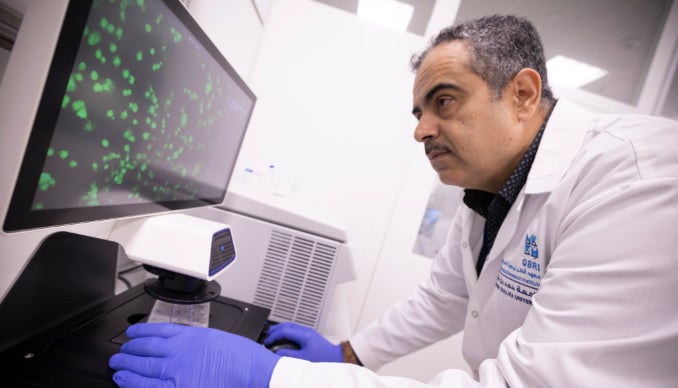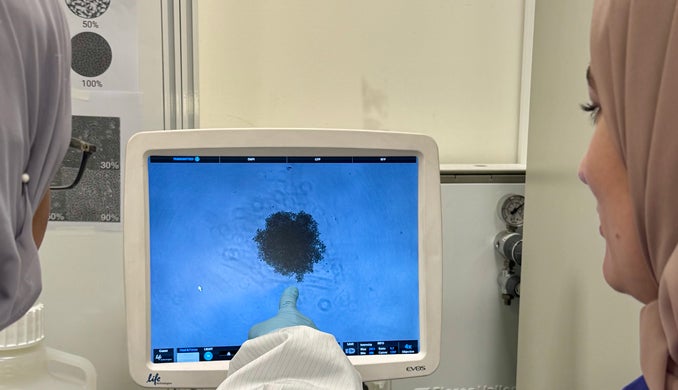April marks Autism Awareness Month, a time for promoting understanding and inclusion for individuals with autism, their carers and families. In this Insight, QBRI’s Dr. Abeer Al-Shammari highlights the importance of public participation in Autism research, the need for early diagnosis and accessible interventions, and more.

Autism is a neurodevelopmental condition that affects how individuals interact, communicate, and experience the world around them. Its core symptoms include difficulties in social interaction, communication and repetitive behaviours. Social challenges include limited eye contact, delayed or absent speech, and difficulty understanding emotions or social cues. Repetitive behaviours may involve hand flapping, jumping, intense focus on specific objectives, and strong resistance to changes in daily routines. While other issues such as anxiety and sleep problems are common among individuals with autism, they are not defining symptoms of the condition.
While the exact cause remains unclear, research studies suggest that several factors including genetic, non-genetic, and environmental factors along with the complex interplay between them may contribute to an increased risk of developing autism. To date, hundreds of genes and multiple environmental factors have been associated with autism, yet no single gene or factor has been identified as causative, adding further complexity to understanding this disorder. The multitude of factors may help explain why autism exists as a spectrum disorder with significant variability in the severity of symptoms. Some individuals with autism exhibit mild-to-moderate symptoms, such as limited language skills but the ability to live independently, while others display severe symptoms, such as being non-verbal and requiring significant support for daily routines and self-care from their family or caregiver.
In the Arab region, the population shares common genetic and environmental characteristics that are distinct from the rest of the world. It is therefore crucial to identify autism risk factors that may be unique and specific to Arab communities. This could eventually lead to personalized diagnostic approaches and tailored therapies to support the needs of individuals with autism in this region. However, this goal cannot be achieved without community support and engagement in autism research.
The Importance of Public Participation in Autism Research
There are several key benefits to public involvement in autism research:
● Better Understanding of Autism: Public participation in autism research enables scientists to identify factors contributing to autism in the Arab region and understand how these might differ from those in other populations around the world. This can help create a more comprehensive and accurate picture of autism in the Arab region, ensuring that research findings are relevant to the local population. Ultimately, this knowledge could drive the development of effective, region-specific strategies for early detection, diagnosis, and care.
● Community Awareness and Advocacy: When the local community is actively involved in research, it can increase public understanding of autism and help challenge misconceptions and social stigma. For example, outdated or inaccurate information may prevent some families from seeking professional help for their children. Others may hesitate to pursue a diagnosis or contribute to autism research due to concerns that it might affect their child's future. These misconceptions can delay timely access to essential support, highlighting the need for greater community engagement in research to raise awareness, promote advocacy efforts, and encourage broader participation in autism research within the local community.
● Public Involvement in Shaping Research Programs: The engagement of families and individuals with autism in research activities can provide researchers with a wide range of experiences and new insights about autism. This can help researchers better understand the challenges faced by affected individuals and their families, design research programs that meet their needs, and foster a sense of involvement. Therefore, public participation will not only help researchers develop more accurate models of autism, but it can also provide the community with a platform to shape the future direction of autism research.
● Personalized Approaches to Autism Diagnosis and Treatment: Each case of autism can vary significantly from another, making the outdated assumption of a one-size-fits-all approach no longer effective in the era of personalized medicine. Public contribution to research is crucial for stratifying autism cases into different subgroups that share common characteristics and have similar needs. This can help researchers develop better diagnostic tools and therapeutic strategies tailored to benefit each defined group of individuals with autism from the local population.
The Need for Early Diagnosis and Accessible Interventions
Although autism is a lifelong condition, early diagnosis and intervention can improve social skills, independence, and overall quality of life. However, many families face significant challenges in obtaining a timely diagnosis due to long waiting times and the limited availability of specialized clinicians. In some cases, families may wait months or even years before their child receives a professional diagnosis. Moreover, the diagnostic process itself is highly subjective, often relying on the expertise of professionals who in some cases require input from a multidisciplinary team. This complexity can lead to further delays, preventing children from accessing early intervention programs crucial for their development.
To address this issue, there is a pressing need for an objective and accessible method of autism diagnosis that supports early detection. Community engagement can play a key role in supporting research efforts aimed at identifying autism biomarkers, particularly within the Arab population. Such discoveries could lead to the development of simple, clinic-based blood tests that enable faster and more reliable diagnoses for autism. This, in turn, would ensure that children with autism receive timely interventions, improving their long-term outcomes.
Beyond early diagnosis, continued research could further enhance our understanding of autism and its biological underpinnings within the local population, which could potentially lead to the development of personalized and innovative therapies, particularly for individuals with severe symptoms. These efforts may result in targeted treatments that reduce symptom severity and enhance the quality of life for these individuals.
The Future of Autism Research
Research has the potential to transform the lives of individuals on the autism spectrum and their families. However, progress in this field depends on public awareness and support for ongoing research initiatives. A key aspect is the development of personalized medicine, particularly for the local Arab population, where genetic and environmental factors influence autism’s presentation and treatment. Greater community participation in autism research activities can help researchers identify unique factors within the local population, leading to the development of more effective diagnostic tools and therapies. Ultimately, collaboration between researchers and the local community can create a future where individuals with autism receive the specialized care and support that they need to thrive.
Written by Dr. Abeer Al-Shammari, Scientist, Neurological Disorders Research Center, Qatar Biomedical Research Institute.
Related News










